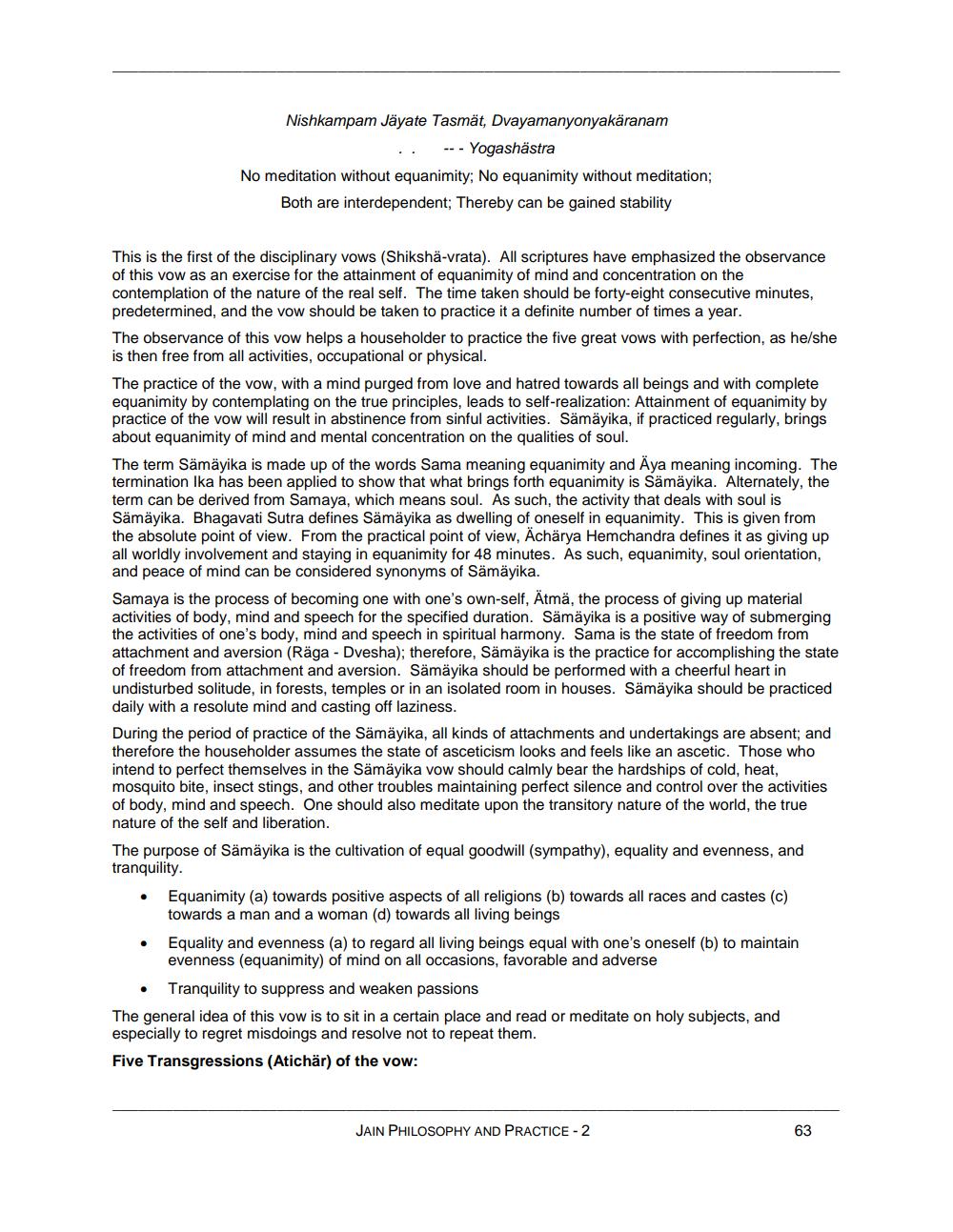________________
Nishkampam Jayate Tasmät Dvayamanyonyakäranam
.. --- Yogashästra No meditation without equanimity; No equanimity without meditation;
Both are interdependent; Thereby can be gained stability
This is the first of the disciplinary vows (Shiksha-vrata). All scriptures have emphasized the observance of this vow as an exercise for the attainment of equanimity of mind and concentration on the contemplation of the nature of the real self. The time taken should be forty-eight consecutive minutes, predetermined, and the vow should be taken to practice it a definite number of times a year. The observance of this vow helps a householder to practice the five great vows with perfection, as he/she is then free from all activities, occupational or physical. The practice of the vow, with a mind purged from love and hatred towards all beings and with complete equanimity by contemplating on the true principles, leads to self-realization: Attainment of equanimity by practice of the vow will result in abstinence from sinful activities. Sämäyika, if practiced regularly, brings about equanimity of mind and mental concentration on the qualities of soul. The term Sämäyika is made up of the words Sama meaning equanimity and Aya meaning incoming. The termination Ika has been applied to show that what brings forth equanimity is Sämäyika. Alternately, the term can be derived from Samaya, which means soul. As such, the activity that deals with soul is Sämäyika. Bhagavati Sutra defines Sämäyika as dwelling of oneself in equanimity. This is given from the absolute point of view. From the practical point of view, Acharya Hemchandra defines it as giving up all worldly involvement and staying in equanimity for 48 minutes. As such, equanimity, soul orientation, and peace of mind can be considered synonyms of Sämäyika. Samaya is the process of becoming one with one's own-self, Atmä, the process of giving up material activities of body, mind and speech for the specified duration. Sämäyika is a positive way of submerging the activities of one's body, mind and speech in spiritual harmony. Sama is the state of freedom from attachment and aversion (Räga - Dvesha); therefore, Sämäyika is the practice for accomplishing the state of freedom from attachment and aversion. Sämäyika should be performed with a cheerful heart in undisturbed solitude, in forests, temples or in an isolated room in houses. Sämäyika should be practiced daily with a resolute mind and casting off laziness. During the period of practice of the Sämäyika, all kinds of attachments and undertakings are absent; and therefore the householder assumes the state of asceticism looks and feels like an ascetic. Those who intend to perfect themselves in the Sämäyika vow should calmly bear the hardships of cold, heat, mosquito bite, insect stings, and other troubles maintaining perfect silence and control over the activities of body, mind and speech. One should also meditate upon the transitory nature of the world, the true nature of the self and liberation. The purpose of Sämäyika is the cultivation of equal goodwill (sympathy), equality and evenness, and tranquility.
Equanimity (a) towards positive aspects of all religions (b) towards all races and castes (c)
towards a man and a woman (d) towards all living beings • Equality and evenness (a) to regard all living beings equal with one's oneself (b) to maintain
evenness (equanimity) of mind on all occasions, favorable and adverse
Tranquility to suppress and weaken passions The general idea of this vow is to sit in a certain place and read or meditate on holy subjects, and especially to regret misdoings and resolve not to repeat them. Five Transgressions (Atichär) of the vow:
JAIN PHILOSOPHY AND PRACTICE - 2
63




